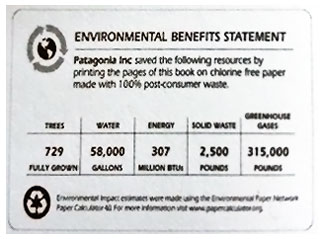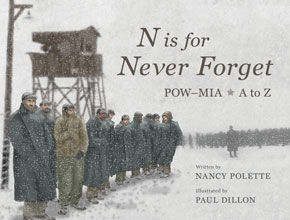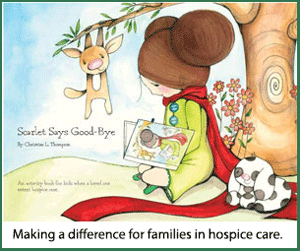As environmentally-conscientious readers awaken to the broad effects of climate change, they begin to consider the sustainability of their purchases. These book buyers, hoping to minimize the environmental footprint of their personal libraries, want to identify and patronize environmentally responsible booksellers and publishers. This opens opportunities for companies to lead a sustainability shift and inform readers about their eco-friendly practices.
“Any company routinely considers the cost of a product they create,” says Hans Cole, Director of Environmental Campaigns and Advocacy at Patagonia, the clothing company. “To move to a more sustainable society, it is imperative that the profit and loss statement include the environmental impact as well.”

A few of Patagonia Books’ environmentally-friendly print books, displayed at the Ventura, California office.
Environmental considerations are part of the corporate identity for Patagonia and its publishing arm, Patagonia Books. Using only recycled paper is one way publishers can reduce the footprint of their products, but not every measure that appears eco-friendly actually makes a positive difference, says Sonia Moore, creative project manager, who handles print production at Patagonia. For example, companies that advertise planting trees as an attempt to offset their use of new paper may not actually be helping the environment.
“Planting a tree for every book sold sounds good, but most likely that tree is being planted where a natural ecosystem has already been disrupted,” says Sonia. She explains these trees might be planted in locations where trees are grown specifically for the paper industry, plantations that are often harmful rather than beneficial to the environment.
Recycling paper, on the other hand, alleviates the need to harvest trees to produce paper, and is a better choice, according to Canopy, a nonprofit that works with the forest industry’s customers and suppliers to develop business solutions that protect the environment.
Patagonia Books informs customers about sustainability practices, like using only post-consumer waste paper, by including an environmental benefits statement on the copyright pages of all their books. Notices like these help readers identify and choose books that are responsibly sourced and produced.

Patagonia Books includes an environmental benefits statement on the copyright pages of all their books.
In her study, Eco-Publishing in the Book Industry, Julie Collins, a graduate researcher at Portland State University, says post-consumer waste paper is a positive option. Recycling paper reduces the use of energy, water, and chemicals, creates less pollution, and diverts paper waste from landfills.
“The environmental sustainability of papermaking is made stronger when humans implement effective systems for recycling and reusing the natural resources (in this case, trees) already taken from the earth,” Julie writes.
More printers now have post-consumer-waste papers available as in-house stocks, and the quality has improved as well, to the point that most recycled papers are just as smooth and white as those made from virgin fibers. This means more publishers are able to print on recycled papers, satisfying growing public interest in ecologically sustainable products.
As well as using recycled paper, there are other measures publishers can employ. They can reduce or eliminate the use of plastic shrink wrap (to protect books in transit) by making sure that books are packed tightly in durable boxes.
To minimize their use of paper, Patagonia now produces only digital advance reader copies instead of mailing paper copies for book reviews and samples. In the past, some reviewers were less likely to accept e-files, but pandemic restrictions have brought changes to these norms. Now some reviewers and award programs accept only digital copies, and more publishers are adopting the use of digital review copies.
“It was disingenuous for Patagonia to print what is essentially a throw-away version of an upcoming book, when a digital copy is just as easy to review,” says Stephanie Ridge whose firm, Wild Ridge PR, handles marketing for Patagonia. “We decided our commitment to protect our home planet was most important, and that we needed to lead the industry to change.”
Publishers who prioritize eco concerns work constantly to improve their sustainability practices and environmental options and include environmental impact as part of their brand. From an industry perspective, companies can minimize waste by carefully monitoring print runs and minimizing returned books. They can also keep books out of landfills by committing not to dump or destroy returned books. Instead, those books can be used as promotional materials or donated to a local library, school, or community center.
Book buyers—with their buying choices—can encourage more publishers and booksellers to operate in ways that protect the environment. Those choices begin with purchasing books that include an environmental benefits statement, showing the publishers’ commitment to eco-friendly practices. Readers can also make a difference to the environment by buying books from local, independent booksellers.
While it may be easy and cheap to order a book from Amazon, there is a higher cost to the environment. Transporting books individually—from publisher to wholesaler, wholesaler to Amazon, Amazon directly to the homes of book buyers—expends more fossil fuel and packaging material than books stocked and purchased at a local store. Buying from an independent bookstore also supports local economies.
Local bookstores can take steps to minimize their environmental impact by carefully bundling their orders to control shipping costs and by recycling or reusing their boxes. There are many other ways small operators can make a difference, and every little thing helps.
For example, Bright Side Bookshop in Flagstaff, Arizona, uses pasta instead of wood coffee stirrers in their café.
“We replaced plastic stir straws with pieces of linguine. It’s cheap, waste free, and a unique feature,” says manager Amy McClelland. She is also interested in highlighting books from eco-friendly publishers and encouraging readers to look for greener options when book shopping.
Although digital reading options eliminate the use of paper, ebooks do have environmental impact. Their footprint occurs in manufacturing the devices, battery production, and electricity needed to charge them. Obsolete or broken readers are also much less recyclable than paper books. A study by the Cleantech group estimated the footprint of an ereader is offset when it is used for at least 22.5 books per year. Audiobooks may have a lighter environmental footprint, since readers generally listen on their smart phones with no additional device required. However, the overall impact of the sales of audiobooks on the publishing industry, particularly for small publishers and bookstores, keeps them from being an ideal option.
Most readers prefer print books some or all of the time. According to Pew Research in 2019, of the 72 percent of Americans who are regular readers, about half of those read print only. Of the other half, most read both print and digital books with a small slice reading only digital editions. Audiobooks are seeing big gains in sales, but print books remain the most popular option. Still, readers are becoming more aware of the need for environmental awareness.
Readers can also make environmental choices after they purchase and read a book. Instead of throwing books away, readers can pass books along to friends or organizations. Many community and senior centers, homeless shelters, libraries, and schools are in need of quality books. Another way to share is to tuck books into a Little Free Library in the neighborhood.
Small steps and actions add up to big changes over time. Considering the environment when buying and reading books does make an impact.
Resources for Eco-Friendly Reading Choices
Why Recycled Paper? from Green America
How to Identify Better Paper from Green America
Paper waste calculator for individuals and organizations from the Environmental Paper Network
“The Environmental Impact of Growing Numbers of E-books in Libraries” by Juliette Denis, Allegra Donadio, and Katherine Klein via Boston College
“The Environmental Impact of Amazon’s Kindle” (comparison of paper vs ereader) by Emma Ritch via Clean Tech
“Eco-Publishing in The Book Industry: An Interdisciplinary Case Study with Patagonia Books” by Julie Collins via PDX Scholar
The Responsible Company: What We’ve Learned From Patagonia’s First 40 Years by Yvon Chouinard & Vincent Stanley
Patagonia Books
Web: Patagonia.com/shop/books
FB: @PatagoniaBooks
TW: @PatagoniaBooks
IG: @PatagoniaBooks
Bright Side Bookshop
Web: BrightSideBookshop.com
FB: BrightSideBookshop
IG: @BrightSideBooksFlag
Canopy
Web: CanopyPlanet.org
EcoPaper Database: EPD.CanopyPlanet.org
FB: @CanopyPlanet
TW: @CanopyPlanet
IG: @CanopyPlanet
Little Free Library
Web: LittleFreeLibrary.org
FB: @LittleFreeLibrary
TW: @LtlFreeLibrary
IG: @LittleFreeLibrary
Karla Olson, a publishing professional for more than thirty years, is publisher at Patagonia Books, chair of the Independent Book Publishers Association, and president of IBPA affiliates Publishers and Writers of San Diego and Publishers and Writers of Orange County. She is also the owner of BookStudio, a publishing consultancy.
This article was first published December 2020.












